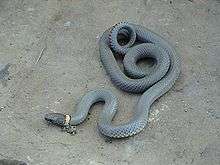Diadophis punctatus regalis
| Diadophis punctatus regalis | |
|---|---|
 | |
| Scientific classification | |
| Kingdom: | Animalia |
| Phylum: | Chordata |
| Subphylum: | Vertebrata |
| Class: | Reptilia |
| Order: | Squamata |
| Suborder: | Serpentes |
| Family: | Colubridae |
| Subfamily: | Dipsadinae |
| Genus: | Diadophis |
| Species: | D. punctatus |
| Subspecies: | D. p. regalis |
| Trinomial name | |
| Diadophis punctatus regalis Baird & Girard, 1853 | |
| Synonyms | |
Diadophis punctatus regalis, commonly known as the regal ringneck snake, is a subspecies of ringneck snake endemic to the southwestern United States and northern Mexico.
Description
The regal ringneck snake is typically gray in color, with a dark-speckled white or cream underside, which becomes bright red or orange near and under the tail.[2] It is distinguished by a yellow to orange ring around its neck which is typically bordered with black. However, the neck ring is frequently absent in this subspecies. The belly color extends onto one or more dorsal scale rows.[3] They are among the larger of the ringneck snake subspecies, growing to a total length (including tail) of 20 to 87 cm (7.9 to 34.3 in). Their dorsal scales are smooth.
Habitat
The regal ringneck snake is found in the mountains, not in the desert.[4]
Diet
The regal ringneck snake, unlike other subspecies, is almost exclusively ophiophagous, having a diet that consists primarily of other snakes, such as the earth snakes (genus Virginia) and the blackhead or flathead snakes (genus Tantilla). They have enlarged rear teeth (opisthoglypha) and a weak venom that serves to immobilize their small prey, but is harmless to humans.
Behavior
Ringneck snakes are nocturnal, secretive snakes which spend most of their time hiding under rocks or other ground debris. If threatened, the ringneck snake typically hides its head and twists its tail in a corkscrew type motion, exposing its brightly colored underside, and expels a foul smelling musk from its cloaca.
Reproduction
Mating occurs throughout the warmer months, with 3 to 10 eggs being laid at a time in a moist, protected area, sometimes in a communal nest with the eggs of several other females. The eggs are on average 19 mm (¾ in.) long by 7 mm (¼ in.) wide.[5]
References
- ↑ The Reptile Database. www.reptile-database.org.
- ↑ Conant, Roger. 1975. A Field Guide to Reptiles and Amphibians of Eastern and Central North America, Second Edition. Houghton Mifflin. Boston. 429 pp. (Diadophis punctatus regalis, pp. 173-174, Figure 38., Map 133.)
- ↑ Smith, H.M., and Brodie, E.D., Jr. 1982. Reptiles of North America: A Guide to Field Identification. Golden Press. New York. 240 pp. (Diadophis punctatus regalis, pp. 160-161.)
- ↑ Schmidt, K.P., and D.D. Davis. 1941. Field Book of Snakes of the United States and Canada. G.P. Putnam's Sons. New York. 365 pp. (Diadophis regalis regalis, p. 113.)
- ↑ Wright, A.H., and A.A. Wright. 1957. Handbook of Snakes of the United States and Canada. Comstock. Ithaca and London. 1106 pp. (Diadophis regalis, pp. 192-200, Figures 61. & 62., Maps 19. & 20.)
Further reading
- Baird, S.F., and C. Girard. 1853. Catalogue of North American Reptiles in the Museum of the Smithsonian Institution. Part I.—Serpents. Smithsonian Institution. Washington, District of Columbia. xvi + 172 pp. (Diadophis regalis, new species, p. 115.)
External links
- California Herps: Regal Ringneck Snake
- Animal Diversity Web: Diadophis punctatus
- Reptiles of Arizona: REGAL RING-NECKED SNAKE Diadophis punctatus regalis